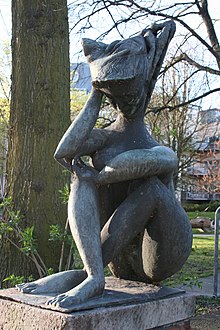Pericle Fazzini

Pericle Fazzini (born May 4, 1913 in Grottammare , † December 4, 1987 in Rome ) was an Italian sculptor . He is one of the most important representatives of modern art after 1945.
Life
Pericle Fazzini trained in his father's workshop, who was a carpenter . During this time he began to make sculptures . In 1929 Fazzini moved to Rome to learn sculpture. He attended drawing courses at the Academy in Rome and learned to draw portraits . In 1932 he won a national scholarship.
Many of his early sculptures are wood carvings that show windswept figures that are portrayed in baroque- like movement in an overflowing imagination. His late, monumental metal works also show these special forms. The Italian poet Giuseppe Ungaretti (1888–1970) therefore referred to him as the “sculptor of the wind”.
In 1935 he met Arturo Martini , who should be a teacher to him. Fazzini became a teacher himself: from 1937 to 1952 at the Museo Artistico Industriale in Rome. He had his first solo exhibition in 1943 in the Galleria La Margherita in Rome in 1943. In 1945 he co-founded the artist group “ Neo-cubista ”, together with Renato Guttuso , Antonio Corpora and other artists.
In the 1940s he created small, twisted bronze sculptures of dancers, cats and acrobats. In 1947 he became a member of the Fronte Nuovo delle Arti . He won the Prize for Sculpture at the Venice Biennale in 1954. Fazzini was professor at the Florence Academy from 1955 to 1959 and at the Rome Academy in 1958. In 1959 he was a participant in documenta 2 in Kassel . In 1968 he was awarded an Antonio Feltrinelli Prize .
One of Fazzini's most important works is the sculpture La Resurrezione (“The Resurrection”) for the papal audience hall in the Vatican (completed in 1975). The hall is shaped by the sculpture, which is around 20 meters wide, seven meters high and three meters deep, which is located in the rear of the grandstand. It depicts Jesus rising from the crater of a nuclear explosion. Fazzini wrote:
“Ho pensato di creare il Cristo come se risorgesse dallo scoppio di questo grande uliveto, luogo di pace delle ultime preghiere. Il Cristo risorge da questo cratere apertosi dalla bomba nucleare: un'atroce esplosione, un vortice di violenza ed energia. "
“I decided to depict the resurrection of Christ in a large olive grove, that peaceful place of his last prayers. Christ rises from a crater that was torn open by an atomic bomb: a cruel explosion, a vortex of violence and energy. "
The sculpture is made of bronze and brass and weighs around 40 tons. It took seven years to work on it. There were twelve years between the Vatican's first contact with the artist and the inauguration of the work in the audience hall.
Fazzini's works have been shown in numerous international exhibitions, biennials and museums. His last work is a monumental monument to Padre Pio in San Giovanni Rotondo near Monte Sant'Angelo in Apulia . The monument depicts the padre with arms raised and expresses the whole stormy movement that characterizes Fazzini's art.
literature
- Giorgio de Marchis: Pericle Fazzini. 1913-1987. Sculptor and painter ; Halle an der Saale Kunstverein 1995
- Exhibition catalog for documenta II (1959) in Kassel: II.documenta'59. Art after 1945 . Catalog: Volume 1: Painting; Volume 2: Sculpture; Volume 3: Graphic Art; Text tape. Kassel / Cologne 1959
Web links
- Examples of his work
- More examples of his work
- Biographical Notes
- Materials by and about Pericle Fazzini in the documenta archive
Remarks
- ^ Obituary / appreciation of the main work, The New York Times , December 5, 1987, (Eng.)
- ↑ Description of La Resurrezione with quotations, illustrations and further references, (ital.)
| personal data | |
|---|---|
| SURNAME | Fazzini, Pericle |
| BRIEF DESCRIPTION | Italian sculptor |
| DATE OF BIRTH | May 4, 1913 |
| PLACE OF BIRTH | Grottammare , ( Ascoli Piceno ) Italy |
| DATE OF DEATH | 4th December 1987 |
| Place of death | Rome , Italy |
